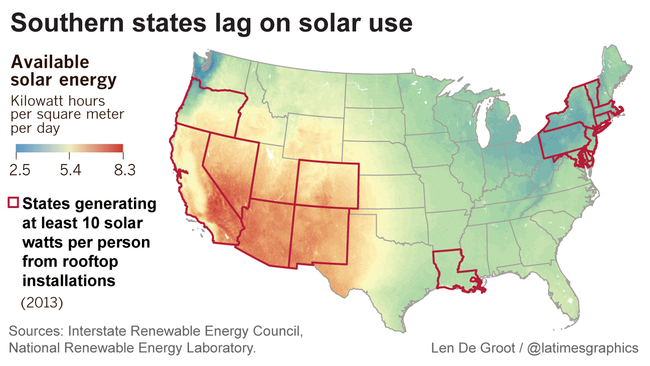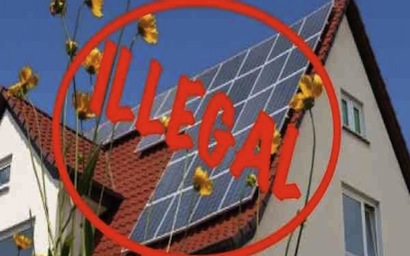
When it comes to solar power, the Southeast U.S.–despite its abundant sunshine–has long been like the kid at the back of the class who refuses to raise her hand: a complete non-participant in the action.
That is now changing, rapidly.

Take North Carolina. From 2010 to 2013, solar capacity skyrocketed from 40 MW to 469 MW, and the growth continues. Solar potential in the state is enormous: a new report says the state could produce 30 times as much electricity as it currently uses with solar power.
And take a look at Georgia. It is now the fastest growing solar state in the country. Regulators there are requiring 525 MW of solar in the state by next year, and Georgia is going to meet that target easily–even without a state Renewable Energy Standard (RES). If the state had such a standard, Georgia’s solar growth could become far greater–especially because virtually all of that 525 MW will be utility-scale–rather than distributed solar.
And how about backward South Carolina? Solar currently is virtually non-existent in the state, despite the fact that one of the state’s major industries is tourism to its sunny beaches at Hilton Head, Myrtle Beach and elsewhere. But a new state law–while not nearly adequate–and ratepayer anger over seven (so far) rate increases associated with the construction of the Summer nuclear reactors–are poised to finally set off solar deployment in the state in a big way.

The big holdout is Florida–“The Sunshine State.” And that it remains the big holdout is a near-criminal abdication of responsibility among the entire state government. In Florida, it is simply illegal for people to install their own rooftop solar; the law requires utilities to own all solar power in the state. There was considerable hope that the election of Charlie Crist as Governor in November would change that dynamic. But Crist lost.
Still, consumer outrage over the early cost recovery laws that have led to ratepayers forfeiting millions of dollars for a nuclear project that will never be built at Levy County–and another that likely will never be built at Turkey Point–has reached the legislature and there is a reasonable chance for repeal this year. And sooner or later, even Florida politicians will have to recognize that if the “Sunshine State” tag is to carry any validity in the 21st century, they will have to take the shackles off the solar power industry. Although some more pushing from Floridians (and a lot of activists already have been pushing hard) couldn’t hurt…
Meanwhile, whether you’re in the Southeast or not, this handy little Mythbuster will help you fight back against those who say we can’t power the world with renewables. Don’t believe them; we can, we will.
Michael Mariotte
November 24, 2014
Permalink: https://www.nirs.org/2014/11/24/solar-comes-to-the-southeast/
Your contributions make publication of GreenWorld possible. If you value GreenWorld, please make a tax-deductible donation here and ensure our continued publication. We gratefully appreciate every donation of any size.
Comments are welcome on all GreenWorld posts! Say your piece above. Start a discussion. Don’t be shy; this blog is for you.
If you’d like to receive GreenWorld via e-mail, send your name and e-mail address to nirs@nirs.org and we’ll send you an invitation. Note that the invitation will come from a GreenWorld@wordpress.com address and not a nirs.org address, so watch for it.
If you like GreenWorld, you can help us reach more people. Just use the icons below to “like” our posts and to share them on the various social networking sites you use. And if you don’t like GreenWorld, please let us know that too. Send an e-mail with your comments/complaints/compliments to nirs@nirs.org. Thank you!
GreenWorld is crossposted on tumblr at https://www.tumblr.com/blog/nirsnet




That is indeed criminal in Florida, especially with the cinder-block houses there. The sunbelt could light up the entire of North America and maybe more. One often forgotten renewable is biogas from food scraps and even cow shit. In rural China they run light bulbs off of animal and people wastes. Waste biogas gets mixed in with the concept of growing corn, etc. for ethanol. Even traditional ethanol could help US farmers who destroy food anyway, but is not good when forest is destroyed to grow biofuel crops. It’s hard to get around the probability that the biogas plant which used chicken scraps in Mississippi was intentionally destroyed. There is an interesting biogas plant using grass clippings in Florida. I have to wonder why Mississippi has Entergy nuclear when it has such a big potential for using agricultural, forestry and food wastes to make biofuel. Entergy is in New Orleans. How the bleep did they get to Jackson, Miss? Katrina? Or, to make sure that Mississippi doesn’t become a renewable state – easy with its small population. The only online paper to be found on using ag waste for biofuels in Mississippi was done at historically black Alcorn State which is very near the largest US reactor, which is in an almost totally black county in the Mississippi Delta. Using kitchen waste for fuel and small hydro (e.g. on the Rhine) is very well-developed in some European towns. There is also algae as fuel. US universities have been unable to get much gov funding and have to seek private sector funding from abroad for research. Algae research is done at German Universities.
Reblogged this on your passport to complaining and commented:
An update on the status of several southern US states regarding solar and specifically Florida’s absurd criminalization of solar installations/